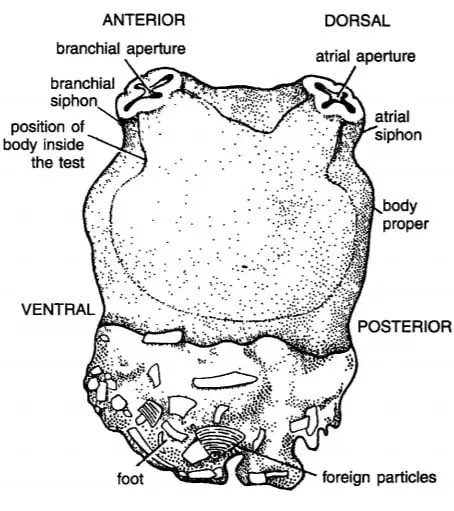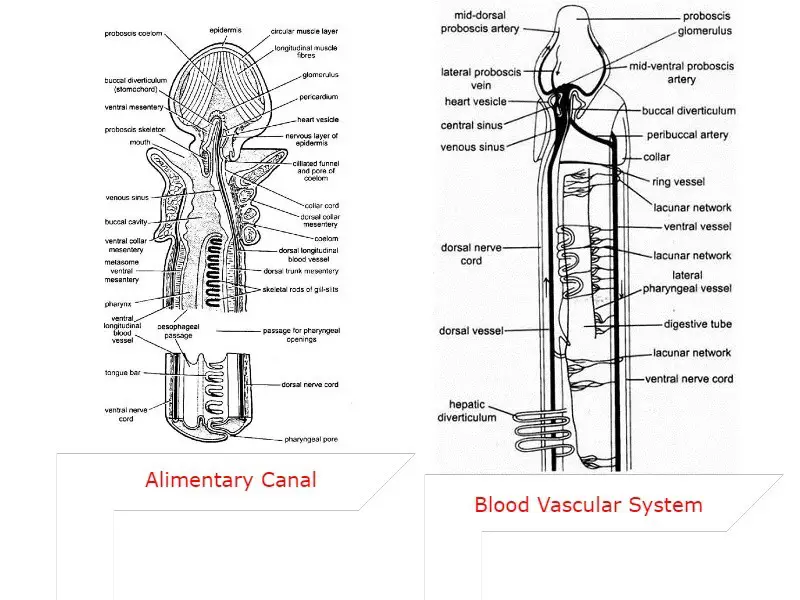Table of Contents
Alimentary Canal:
The alimentary canal in Hemichordata is straight, complete starting in mouth opening and an end in the anus, the alimentary canal in Hemichordata is much narrow. In Urochordata the alimentary canal is complete but it is not simple, it is not straight, intestine forms a loop, due to the presence of the intestinal loop the alimentary canal in the Urochordata is curved. In Hemichordata the alimentary canal is complete and straight, the alimentary canal starts at the mouth and ends in the anus after the anus post-anal tail is present.
Mouth Opening:
In Hemichordata the mouth remains concealed in between collar and proboscis, the mouth opening is wide and circular, open outside mid-ventrally. In Urochordata the the branchial siphon open into branchial aperture, the branchial aperture represent the mouth which is guarded by four-lobe. In Cephaochordata the mouth opening presents on the anterior side ventrally, the mouth opening is surrounded by a buccal hood with tentacles like sensory buccal cirri.

Buccal Cavity:
The wide circular mouth in Hemichordata open into short buccal cavity, the buccal cavity in Hemichordata do not bear any tentacles like structure. In Urochordata, the branchial aperture opens inside into branchial siphon, inside the branchial siphon the branchial tentacles are present in ring-like circular arrangements. In Cephaochordata the buccal cavity actually represented by the space present in the buccal hood region, in this region wheels organ present which creates the water current.
Pharynx:
In Hemichordata the pharynx shows distinct regions, lateral peribranchial ridges, the dorsal branchial portion with gill slits, and the ventral digestive portion responsible for digestion. In Urochordata, two ciliated peribranchial ridges separate the anterior small prebranchial zone and posterior large branchial sac region with gill slits. In Cephaochordata the large-sized pharynx is divided by the oblique ciliated peripharyngeal bands into anterior-dorsal prebranchial zone and posterior large branchial sac.
Velum:
In Cephaochordata when the pharynx opens into the esophagus, a membrane-like septum presents vertically known as velum, at the center of the velum a perforation is present. The perforation of the velar membrane connects the pharynx to the esophagus, the perforation of the velar membrane is lined by some tentacles-like structure known as velar tentacles, in Hemichordata and Urochordata velum absent.

Endostyle:
Endostyle is a special feature in Cephaochordata and in Urochordata but it remains absent in Hemichordata. In Urochordata and Cephaochordata the ventral floor or pharynx endostyle present along the mid-ventral line of pharynx.
Hypopharyngeal Groove:
In Cephaochordata the roof of pharynx have a ciliated groove along the mid-dorsal line of pharynx it is known as epipharyngeal or hypopharyngeal groove or band. In Cephaochordata the hypopharyngeal Groove help in collecting food particles from the water current, in Urochordata, the tongue-like process present in the pharynx represents the epipharyngeal groove but in Hemichordata it is absent.
Gill Slits:
In Hemichordata the branchial portion of pharynx have gill slits, the gill slits present dorsolaterally, the gill slits are U shaped supported by M shaped endoskeletal structure. In Hemichordata numerous gill slits open into the atrial cavity, in Cephaochordata the gill slits present on the pharyngeal wall do not open outside directly. In Cephaochordata the pharynx is surrounded by atrial cavity, so the gill slits open into the atrial cavity then the atrial cavity open outside through atriopore.
Stomach:
In Hemichordata the intestine does not show a clear region of the stomach but in Urochordata, the stomach is clearly separated from the alimentary canal by the sphincter at both ends. In Cephaochordata the stomach not separate from the alimentary canal, most of the digestive occur in midgut diverticulum.
Digestive Glands:
In Hemichordata there are no special associated glands with the alimentary canal to digest the food but in Urochordata liver, the pyloric gland, and the secretory tissue in the intestine are important digestive glands. In Cephaochordata live do not present but the midgut diverticulum performs the functions of the liver, the pyloric gland is absent in Cephaochordata.

Anus:
In Hemichordata the alimentary canal open outside through the anal pore opening at the tip of posterior end of the body, the anus is guarded by sphincters. In Urochordata, the digestive tract opens outside the atrial siphon which opens outside through the atrial aperture. In Cephaochordata the alimentary canal end into the anus at base of tail, after the anus spender posterior part forms the post-anal tail.
Detailed Study On
Cephalochordata Characteristics Features Affinities Classification Systematic Position
Subphylum Urochordata: Characteristics Classification Examples
Reference
Cephalochordata Characteristics Features Classification Examples and Diagram
Urochordata Classification Morphology Characteristic Features
Characteristics Features of Hemichordata
General Comparison of Hemichordata Urochordata and Cephalochordata
Hi Everyone!!! Welcome to Imaluop. Imaluop always try to learn some new and he want to share to other people. Here we will try to learn various topics on Science, specially on Biological Sciences.